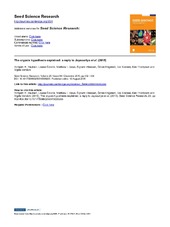| dc.contributor.author | Paulsen, Torbjørn Rage | |
| dc.contributor.author | Colville, Louise | |
| dc.contributor.author | Daws, Matthew I. | |
| dc.contributor.author | Eliassen, Sigrunn | |
| dc.contributor.author | Högstedt, Göran | |
| dc.contributor.author | Kranner, Ilse | |
| dc.contributor.author | Thompson, Ken | |
| dc.contributor.author | Vandvik, Vigdis | |
| dc.date.accessioned | 2016-03-16T09:20:18Z | |
| dc.date.available | 2016-03-16T09:20:18Z | |
| dc.date.issued | 2015-08-18 | |
| dc.Published | Seed Science Research 2015, 25(4):402-408 | eng |
| dc.identifier.issn | 0960-2585 | en_US |
| dc.identifier.uri | http://hdl.handle.net/1956/11671 | |
| dc.description.abstract | In imbibing seeds, resumption of metabolism leads to the unavoidable release of volatile by-products that are perceived as cues by rodent seed predators. The crypsis hypothesis proposes that the primary function of a water-impermeable, hard seed coat is to reduce rodent seed predation by rendering seeds olfactorily cryptic. In an opinion paper, Jayasuriya et al. (2015) find the crypsis hypothesis unscientific and ‘not consistent with Darwin's theory of evolution by natural selection’. It is unfortunate that Jayasuriya et al. (2015) did not appreciate that the crypsis hypothesis offers an alternative explanation for the evolution of water-impermeable seeds: released seed volatiles are cues used by rodents to locate seeds, and variation in seed-coat permeability leading to differences in seed volatile release represents the variable under selection. Furthermore, the sealing of water-impermeable seed coats imposes a cost of increased generation time and, therefore, dormancy-release mechanisms are expected to subsequently evolve in response to local environmental conditions. We also disagree with most other claims by Jayasuriya et al. (2015), who failed to appreciate how species with dimorphic seeds – one morph with permeable and the other with impermeable seed coats – benefit from rodent caching behaviour and population dynamics. We welcome this opportunity to clarify and elaborate on key features and the evolution of water-impermeable seed coats according to the crypsis hypothesis. | en_US |
| dc.language.iso | eng | eng |
| dc.publisher | Cambridge University Press | en_US |
| dc.rights | Attribution CC BY 4.0 | eng |
| dc.rights.uri | http://creativecommons.org/licenses/by/4.0 | eng |
| dc.subject | crypsis hypothesis for evolution of physical dormancy | eng |
| dc.subject | physical dormancy | eng |
| dc.subject | rodent | eng |
| dc.subject | seed dispersal | eng |
| dc.subject | Seed predation | eng |
| dc.subject | volatile compounds | eng |
| dc.title | The crypsis hypothesis explained: a reply to Jayasuriya et al. (2015) | en_US |
| dc.type | Peer reviewed | |
| dc.type | Journal article | |
| dc.date.updated | 2015-12-11T10:01:55Z | |
| dc.description.version | publishedVersion | en_US |
| dc.rights.holder | Copyright Cambridge University Press 2015 | en_US |
| dc.identifier.doi | https://doi.org/10.1017/s0960258515000288 | |
| dc.identifier.cristin | 1298999 | |
| dc.subject.nsi | VDP::Matematikk og Naturvitenskap: 400 | en_US |

